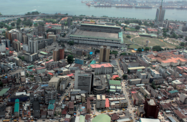Higher levels of energy production, supported by rising prices, underpinned a recovery in Nigeria’s economy in 2017, with further gains expected this year.

The Nigerian economy moved out of recession by the end of June, after four quarters of negative growth triggered largely by lower global energy prices and a reduction in oil output.
Renewed momentum was maintained in the third quarter, with real GDP up 1.4% year-on-year (y-o-y) and 0.68% on the previous quarter. According to data issued by the National Bureau of Statistics (NBS) in late November, the economy had grown 0.43% year-to-date by end-September.
Oil output reaches highest level since early 2016
One of the factors contributing to the improved economic performance was an upturn in oil production. Output from Nigeria’s fields averaged 2.03m barrels per day (bpd) in the July-September period, up 420,000 bpd y-o-y and 150,000 bpd higher than production in April-June, according to the NBS.
The third quarter results were the highest since the first quarter of 2016, when output averaged 2.05m bpd. Improved growth was reflected in oil’s contribution to the broader economy, which rose one percentage point over the previous quarter to 10.04% of GDP.
The energy sector could see greater investment in 2018; in its November budget, the government announced plans to restructure state equity in joint-venture oil assets over the coming year.
Under the proposals, the state would reduce its partnership holdings in downstream energy to generate funds for the budget and increase private sector participation in the industry. Officials have said the partial privatisation could raise N710bn ($2bn).
Muted growth in non-oil sector
The rebound in the energy sector was in part offset by a subdued performance from the non-oil economy, a trend that has endured since early 2016.
The non-oil sector contracted by 0.76% y-o-y in July-September, following growth of 0.72% and 0.45% in the first and second quarters, respectively. According to the NBS, manufacturing was one of key underperforming sectors, recording negative growth of 2.85%, compared to a 0.64% y-o-y decline in the previous quarter.
Growth in the construction sector, meanwhile, was up 5.67 percentage points y-o-y, albeit having eased 0.59 percentage points from the previous quarter.
Despite its muted performance and energy’s rising contribution, the non-oil component still accounted for nearly 90% of GDP, down only marginally from previous quarters.
Inflation still above 15%, rates steady
Inflation remained stubbornly high in 2017, despite easing after a spike at the beginning of the year.
The consumer price index was running at 15.9% at the end of November, marginally down from October’s level and below the year’s peak of 18.72% in January, according to data issued by the NBS. Above-average food inflation, which stood at more than 20% in October and November, prevented it from easing further.
Though there were signs that inflation was beginning to moderate, the Central Bank of Nigeria chose to hold its monetary policy rate at 14% at its November meeting level, the same rate maintained throughout 2017.
While acknowledging that a high rate could weigh on growth and stability, the Monetary Policy Committee said it would have a positive impact on inflation and support exchange rate stability.
Growth set to continue into 2018
The economy’s recovery is expected to gain modest momentum in 2018 and beyond.
However, forecasts for growth vary, with the IMF anticipating 1.9%, the World Bank 2.5% and Moody’s 3.3%.
In its annual credit analysis, released in early December, Moody’s said the continuing recovery in oil production would pave the way for more robust medium-term prospects, assisted by improved transparency in the energy sector and others.
Moody’s added that a rebound in the economy would be matched by an improvement in the fiscal balance; the budget deficit is projected to ease from 3.6% of GDP in 2017 to 3.2% in 2018.
This largely upbeat assessment came after Moody’s lowered the Nigerian government’s long-term issuer and senior unsecured debt rating from “B1” to “B2” in November, citing continued exposure to oil price movements. While debt remained constrained, Moody’s said the government’s balance sheet was structurally exposed to further economic or financial shocks.


